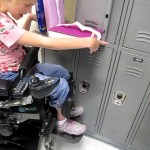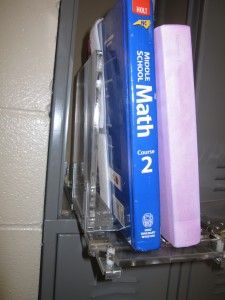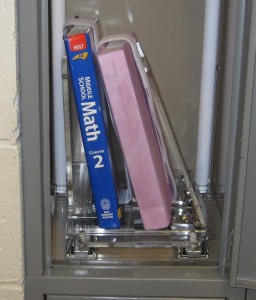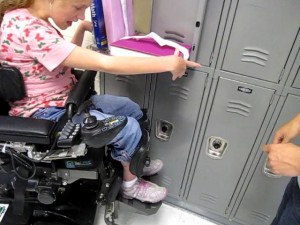Designers: Kevin D’Auria and Bo Xiao
Client Coordinator: Charlotte Hughes, PT
[youtube]http://www.youtube.com/watch?v=TtLe_0-0fUg[/youtube]
INTRODUCTION
Our client is a 13 year old middle school student who has cerebral palsy and uses a power wheelchair. She has significant problems getting books in and out of her school locker due to arm weakness, tightness and coordination. Our client has better muscle strength and control in her right arm, but she seldom uses her left arm. Thus it is hard for her to manage the heavy textbooks using one arm. Being in a wheelchair, she is positioned lower relative to the locker (she uses an upper locker of two vertically stacked lockers). Thus she is forced to lift the books almost to the height of her head. In addition, her wheelchair positions her further away from the locker, forcing her to extend her arm and torso as she reaches into the locker, which puts her in a disadvantaged mechanical position. We developed a sliding shelf that makes it easier and faster for her to remove books from her locker, as well as place books back into her locker.
SUMMARY OF IMPACT
The client stated, “I think the locker assist will make it easier for me when switching classes because I will not be as dependent on others to get books in and out of my locker. It should make it faster and less stressful for me to make the change. I think it will also help to keep my locker better organized.”
TECHNICAL DESCRIPTION
The design is based on a sliding shelf that mounts to the insider of the client’s locker. There is also a folding flap that assists in loading textbooks. She can easily place the book horizontally on the flap, and then rotate the flap to put the book to a vertical position on the shelf. Also, we developed simple velcro straps that wrap around any textbook and act as a handle to aid her in grasping and lifting a book.
The base of the entire assembly was made out of 3/8” thick clear acrylic that was cut to fit the dimensions of the inside of the locker. Two 10” long, ball-bearing drawer slides were loaded on to the base using machine screws with nuts counter bored into the base. When fully extended, the drawer jutted 8” out from the locker. To counter the moment created by books on an extended drawer, we installed stabilizing rods that ran from the top of the locker down to the base. These rods, screwed into the base, consisted of two concentric and hollow rods that were threaded so they could be extended in length to fit tightly in the locker and exert force on the base. The mechanism is similar to a shower curtain rod that pushes against opposing walls. In this manner, the device can be easily removed from the locker and put into a new locker each school year.
A vertical piece of acrylic was mounted to the left side of the base. This provides one “bookend” for one side of the shelf. The rotating flap was also made of acrylic, cut to 4” by 9”, and attached to the right side of the base using two hinges. As the flap rotates vertically, it becomes the opposite “bookend”. In order to keep the bookends tight against the books so that the books stay in place, the flap can slide left and right along the base on a set of two linear rails.
While our client is capable of lifting a textbook, it is difficult for her to grasp it. We made a book handle using a loosely fitting, adjustable Velcro strap that loops around the cover of a book. This also helps to keep the book closed during transfers in and out of the locker. The cost of the device is $245.





University Operator: (919) 962-2211 | © 2024 The University of North Carolina at Chapel Hill |